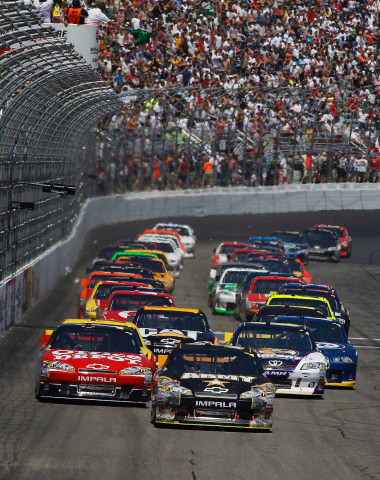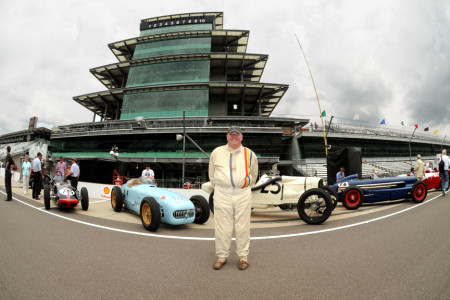The Way It Is/ Working with Racemaker Pressby Gordon Kirby |
 I'm sorry if I offended some readers with last week's column wherein I wrote that in this day and age all of America's best, most accomplished drivers are racing in NASCAR. Most of you seem to believe, in a rather sad and resigned way, that this is an irretutable fact but some non-believers remain out there. Most longtime road racing fans and open-wheel road and oval racing fans would love to see a different story with the top road racers and open-wheel racers recognized as the best, as they were for most of a century. But as I've written before and once again last week, that's no longer the case.
I'm sorry if I offended some readers with last week's column wherein I wrote that in this day and age all of America's best, most accomplished drivers are racing in NASCAR. Most of you seem to believe, in a rather sad and resigned way, that this is an irretutable fact but some non-believers remain out there. Most longtime road racing fans and open-wheel road and oval racing fans would love to see a different story with the top road racers and open-wheel racers recognized as the best, as they were for most of a century. But as I've written before and once again last week, that's no longer the case.
For close to a hundred years we enjoyed many generations of great American Indy car drivers and half a century of great American sports car and road racers, including some F1 stars. But thirty-three years have passed since Mario Andretti scored the last F1 win by an American driver and 35 years have gone by since John Watson drove Roger Penske's car to the last victory for an American F1 team. Over the past twenty or thirty years for many reasons the sport's focus shifted elswhere in America to NASCAR. Each of Indy and sports car racing have fumbled the ball through a series of power struggles and turnovers in sanctioning bodies. During the same time NASCAR went from strength to strength benefitting from decades of steady growth and success. Through the Big Bill France and Bill Jr. eras NASCAR did a tremendous job of controlling and expanding its strain of motor racing so that today it is unchallenged as America's number one form of racing. Helped for more thn a quarter-centry by its partnership with Winston cigarettes NASCAR was ready for the TV age and dominates the medium in America today. And of course, amid all this dramatic changing of America's racing landscape most if not all of America's most renowned drivers have become NASCAR racers.  © LAT USA Back then Formula Ford was thriving not only in the UK but here in the United States and Canada as well. The major races drew big fields with plenty of good young drivers and motivated little teams. Many of them were anxious to move up the ladder. With the Indy 500 at an historic height in those days plus F1 thriving at Watkins Glen, the Can-Am series still booming, Formula 5000 and Trans-Am equally healthy, and many great American drivers racing successfully in a wide variety of cars there was plenty of belief in and motivation about the importance and value of road racing and Indy car racing. Indeed, at the time NASCAR was just one of many players on the national racing scene and was considered by many to be merely a regional Southeastern force. I have to say, back in '71 as a young road racing aficionado, I was pretty contemptuous of both NASCAR and oval racing. But as I cast an eye at the cars in the pits and watched them on the big track that weekend at Talladega forty years ago my mind started to change. My NASCAR education began that weekend and over 35 Daytona 500s and a bunch of other NASCAR races I've covered across the years I've come to understand that you denigrate stock car racing and left turn only tracks at your peril. There's much more to it from both the drivers and teams perspectives than some believe. And too, today's Sprint Cup, Nationwide and Truck Series have created a huge industry with plenty of strong teams, suppliers and vendors. As everyone knows the top teams--Hendrick, Joe Gibbs, Roush Fenway--run four cars and many others--RCR, Penske, Earnhardt-Ganassi, Stewart-Haas, Michael Waltrip, Petty, Red Bull--run two or three cars. All these teams are big operations and there's substantial investment in building and fielding huge, annual fleets of fourteen or fifteen cars for each driver. An equal effort goes into engine-building and development and wind tunnel work too. All this results in the deepest and strongest field in racing. Next weekend, American sports car racing enjoys one of its biggest races of the year. The Petit Le Mans at Road Atlanta joins Sebring as the two high points of the American sports car season and we're fortunate to have two such classics in the United States but wouldn't it be great if the other ALMS races could enjoy equally strong fields. That's unlikely to happen because of the structure of the new World Sports Car Championship and the ongoing fact of life that the Grand-Am and ALMS's dual existences are not good for sports car racing as a whole. A unified series is needed but it's a fact of life that's unlikely to change in the forseeable future. I applaud the ALMS for encouraging the Delta Wing project and for its plans to introduce a Delta Wing category if the prototype proves successful. I also applaud the ALMS for introducing Richard Neuart's URC retro Can-Am category next year. Two such opposite categories could produce some added intrigue and attraction for the ALMS. On the Indy car front everyone hopes that next year's new Dallara and competing engines from Honda and Chevrolet will breath new life into IndyCar. A lot's riding on the new formula and it's good to see early testing of the new car and Honda's new turbo engine going well. It will be interesting to watch Dallara, Honda, Chevrolet and the teams gear up for some serious post-season testing. It will also be good to see new cars and engines in action next year and will produce a spark that's been lacking in recent years for teams, drivers and fans. All of us would love to see IndyCar begin to forge a new, upward-curving path. Here's hoping it happens. In the meantime NASCAR reigns as the king of American racing with by far the biggest share of the market as well as the biggest names in superstars like Jeff Gordon, Jimmie Johnson, Tony Stewart, Kyle and Kurt Busch, Kevin Harvick and Carl Edwards plus of course NASCAR's most popular driver Dale Earnhardt Jr. You may not it, but it's hard to argue against the fact that NASCAR and its stars are in a category of their own.  © Paul Webb But in recent months with Carl and Berni Haas's consultation we've decided to put off publication until a later, yet to be determined date. This will enable us to include an important chapter about this year's successful turnaround season with Oriol Servia and James Hinchcliffe and to add a fresh look at Newman/Haas's hopes for the future. We'd like to end the book on as strong a note as possible and as we draw nearer we'll keep you informed about the book's long-awaited final publicaton date. Through the process of editing and photo-editing the Newman/Haas book I've developed an enjoyable working relationship with Joe Freeman and his small but first-class team at Racemaker Press. Joe is an accomplished writer, editor and historian of American racing. He has published numerous articles on American racing history in Automobile Quarterly and other publications and also is an enthusiastic vintage Indy car collector and racer . Joe is the former President of the Society of Automotive Historians and the past President of Boston's Larz Anderson Automobile Museum. He was selected 'Collector of the Year' at last year's Lime Rock vintage festival and is a regular competitor in historic races driving his 1915 Duesenberg Indy car, the 1946 Sparks/Thorne 'Little Six', his 1953 Kurtis Kraft 500A-Chrysler and 1958 Joe Hunt Magneto Ewing-Offy roadster. Joe is a big fan of American open-wheel racing and one of its biggest and most knowledgeable supporters. He has assembled an excellent research trove at Racemaker Press of more than 500,000 pieces including a tremendous archive of American racing photography from the early days of the twentieth century through today as well as a comprehensive library of books, annuals, magazines, posters and memorabilia. Over the past few months Joe and I have talked about many ideas for other books and we've made an agreement for me to edit, develop and write a series of Racemaker books over the coming years. I've started working on the first of these projects and we'll announce them as we get them firmed up and committed to printing and publishing. In addition to working with Joe on what we hope will be many book projects to come he's also agreed to support my work here at 'The Way It Is'. It's a pleasure to work with Racemaker and provides a perfect match with my work for Motor Sport magazine in the UK and an exciting new phase in my career. For more information about Racemaker Press and its books follow the link to Racemaker.com. |
Auto Racing ~ Gordon Kirby Copyright 2011 ~ All Rights Reserved |
